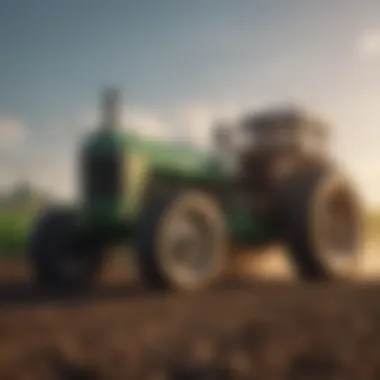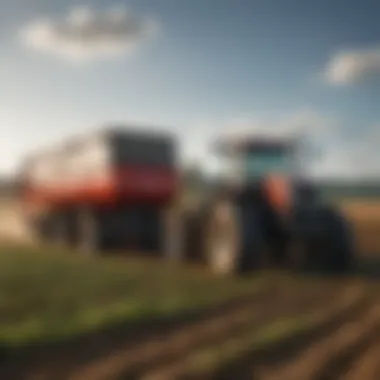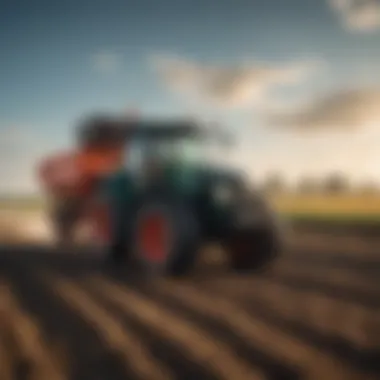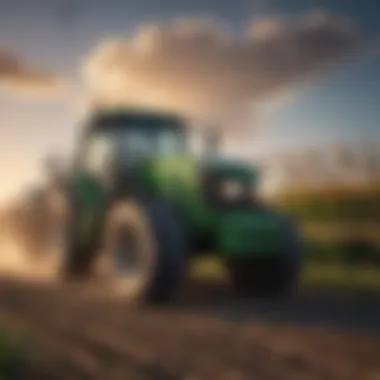Exploring the Legend Air Ride in Modern Agriculture


Intro
The integration of advanced technologies into the agricultural sector is not just a trend but a necessity. One such innovation is the Legend Air Ride system, a profound advancement that influences how equipment is handled and farm operations are executed. Understanding this system is crucial for modern farmers who seek improved efficiency and productivity on their farms. This article aims to dissect the components of the Legend Air Ride, providing context and insights that will empower both novice and experienced farmers alike.
Topic Overview
Definition and Importance
The Legend Air Ride system can be defined as an innovative transportation solution designed to enhance the ergonomics and functionality of agricultural equipment. It utilizes air cushioning technology to minimize the impact of terrain variances, thereby preserving both equipment and produce during transit. The importance of such a system lies in its capability to reduce downtime and maintenance costs, ultimately leading to a more productive farming process.
Brief History and Evolution
Historically, farmers have relied on various methods of transporting goods and machinery. Traditional methods often resulted in damage to crops and wear on equipment due to constant jarring motion over land. With the evolution of mechanical systems, innovations began to emerge in the form of air ride technology. The Legend Air Ride system stands at the forefront of this evolution, showcasing how agricultural methodologies can adapt to modern needs. Its design reflects years of research and development, aiming to maximize efficiency while minimizing adverse effects on both products and soil.
Key Techniques and Innovations
Sustainable Farming Practices
Incorporating the Legend Air Ride into farming not only enhances transportation but also supports sustainable practices. By reducing the physical stress on crops during movement, this system contributes indirectly to lowering food waste.
Advanced Agronomic Technologies
The Legend Air Ride system aligns with the adoption of advanced agronomic technologies. These include automated machinery equipped with precision farming tools. Through the use of data analytics and real-time feedback, farmers can optimize their operations and adapt to ongoing changes in conditions. The synergy between air ride systems and these technologies showcases the future of agriculture.
Practical Applications
Step-by-Step Guides
- Assess Equipment Needs: Evaluate your current transportation methods and identify areas needing improvement.
- Select Appropriate Legend Air Ride Model: Choose a model that aligns with your institutional goals and operational scale.
- Installation and Calibration: Proper installation is crucial. Follow manufacturer guidelines for optimal calibration to suit your farm's needs.
- Training Personnel: Invest time in training to ensure operators understand how to maximize the benefits of the system.
Case Studies or Real-World Examples
Many farms have successfully integrated the Legend Air Ride system. For example, a large corn farm in Illinois reported a 30% decrease in crop damage during transportation after adopting this technology. Such real-world applications illustrate not just the viability but the potential benefits of incorporating air ride systems into agricultural routines.
"The Legend Air Ride system has revolutionized the way we transport goods, reducing costs and enhancing efficiency across the board." - A leading agronomist
By embracing the Legend Air Ride, farmers are not merely upgrading their equipment; they are investing in a future of agricultural practices that prioritize both productivity and sustainability.
Intro to Legend Air Ride
In recent years, the agricultural industry has faced increasing demands for efficiency and sustainability. The introduction of the Legend Air Ride system represents a significant evolution in equipment handling and transportation. This section serves to elucidate the relevance of air ride technology in agricultural operations. Understanding how this innovative system integrates into modern farming practices is crucial for those looking to enhance productivity and reduce operational costs.
The Legend Air Ride technology revolutionizes traditional methods. It employs air suspension to provide smoother rides for agricultural equipment. This leads to better stability and minimizes damage to the crops. The primary goal is to optimize equipment function while ensuring minimal disturbance to the soil and maximized crop yields.
Moreover, the implications of utilizing such systems go beyond immediate benefits. Investment in air ride technology can improve long-term profitability through fuel savings, reduced maintenance costs, and extended equipment lifespans. As farmers face challenges such as soil compaction and uneven terrain, understanding these elements is fundamental for strategic decision-making.
Understanding Air Ride Technology
Air ride technology utilizes primarily pneumatic systems. These systems involve inflatable bags filled with air that replace traditional steel springs found in many vehicles. The soft and adaptable nature of air provides unique advantages. It absorbs shocks effectively, while also allowing for adjustments based on load weight and conditions.
An essential component of air ride technology is its adjustability. Sensors can automatically regulate air pressure, tailoring the suspension to specific conditions. This feature is vital in agriculture where field conditions can vary widely.
The impact of air ride systems on vehicle dynamics is notable. Smoother rides lead to less wear and tear on equipment, improving its overall performance. Also, operators tend to experience lower levels of fatigue. The technology not only enhances productivity but also contributes to the well-being of the operators.


Historical Context and Development
The evolution of air ride systems spans several decades. Initially developed for heavy-duty trucks in the mid-20th century, this technology has gradually found its way into agricultural equipment. Early adopters recognized the advantages of air suspension systems in reducing potential damage to crops and improving overall ride quality.
As the agricultural sector evolved, so did the technology. Manufacturers began to tailor air ride solutions specifically for tractors, combine harvesters, and other machinery utilized in farming. This shift was propelled by the increasing need for efficiency and sustainability amidst growing pressures from both environmental and economic fronts.
Today, numerous agricultural companies integrate advanced air ride technology into their product offerings. These developments reflect a broader trend towards embracing innovation. In essence, the historical progression of air ride technology underscores its growing significance within the agriculture sector, setting the stage to explore its benefits and applications.
Mechanics of Air Ride Systems
Understanding the mechanics of air ride systems is crucial to grasping how these systems enhance agricultural practices. Air ride technology fundamentally changes how equipment interacts with the ground and the load it carries. As such, it is essential for professionals in agriculture, from farmers to machinery operators, to understand both the mechanical components and the operational principles driving these systems.
Components of Air Ride Systems
Air ride systems consist of several core components that work together to provide smooth operation and effective load management. Here are the primary elements:
- Air Springs: These bladders filled with compressed air adjust the vehicle’s height and respond to the load dynamically. They help absorb shocks and maintain a consistent ride height.
- Valves: These control the flow of air into and out of the air springs. The precise management of air pressure is vital for achieving optimal performance and comfort.
- Compressor: This component pumps air into the system. It ensures that sufficient pressure is available in the air springs to accommodate varying loads and road conditions.
- Sensors: These provide real-time data to adjust the air pressure automatically, based on the load and driving conditions. This capability enhances performance and stability.
- Control System: A central electronic unit manages the operation of valves and the compressor, coordinating the system's functioning for maximum efficiency.
The effective integration of these components allows air ride systems to outperform traditional suspension systems, especially in challenging agricultural environments.
Operational Principles
The operational principles of air ride systems rely on the behavior of air under pressure and the interaction between vehicle and load. Air ride technology operates on the principle of compressibility of air, which is utilized to cushion and stabilize loads during transport.
- Compression and Expansion: As a load is applied, the air inside the springs compresses. This compression absorbs shock forces, allowing for a smoother ride. When the load is removed, the air expands, returning the air spring to its original shape.
- Dynamic Adjustment: The system's ability to adapt to load changes is critical. Sensors detect vehicle weight and adjust air pressure in real time, maintaining stability and comfort. This feature is particularly useful in agriculture, where uneven terrain can create unpredictable conditions.
- Pressure Regulation: By adjusting the pressure within the air springs, the system can effectively manage variations in load. For example, a fully loaded trailer will require different air pressure than an empty one. This adjustment is automatic and ensures optimal performance throughout the day.
"A well-functioning air ride system can mean the difference between successful operations and costly downtime in agricultural activities."
Understanding these mechanics provides insights into why many agricultural enterprises are increasingly integrating air ride technologies into their operations. As modern agriculture evolves, the need for advanced machinery that can adapt to changing conditions becomes more essential. Air ride systems exemplify this trait, offering both stability and control that enhances productivity in the field.
Benefits of Legend Air Ride in Agriculture
The benefits of Legend Air Ride systems in agriculture are multifaceted. These systems significantly enhance the overall operations and productivity of agricultural activities. As farm machinery becomes more advanced, the integration of air ride technology is proving to be a pivotal advancement. Farmers and operators can experience smoother rides and improved efficiencies, which are critical in modern farming.
Enhanced Equipment Stability
One of the primary advantages of air ride systems is the enhanced stability they provide to farming equipment. Traditional suspension systems may not absorb shocks effectively, causing discomfort to operators and potential damage to the equipment. With air ride technology, the cushioning effect absorbs irregularities in the terrain. This leads to a reduction in vibrations, ensuring that machinery operates within its optimal parameters.
Operators can expect less wear and tear on tractors, trailers, and other equipment. By maintaining stability during transit, the systems also ensure more accurate and efficient work processes. This is especially important while navigating uneven fields or rough roads.
Reduction of Soil Compaction
Soil compaction is a growing concern for farmers. Compacting happens when heavy machinery repeatedly passes over fields, leading to reduced soil aeration, drainage issues, and stunted crop growth. The Legend Air Ride system directly addresses this issue by distributing weight more evenly.
By reducing the weight impact on the soil, the air ride systems minimize the potential for compaction. This leads to healthier root systems and improved soil structure. Farmers can benefit from greater productivity when they deploy machinery equipped with air ride suspensions. The reduction in soil compaction ultimately supports sustainable agricultural practices, promoting a balanced ecosystem.
Improved Crop Yield and Quality
Lastly, the potential for improved crop yield and quality is a significant benefit of using Legend Air Ride systems. When soil health improves due to reduced compaction, crops have a better environment for growth. In addition, the stability provided by air ride technology allows for precision farming techniques.
Farmers can operate their machinery at optimal speeds, ensuring that planting, fertilization, and harvesting occur efficiently. This operational efficiency leads to better crop quality and higher yields. Research continually highlights the connection between effective agricultural practices and yield outcomes, further emphasizing the need for advanced technology in modern agriculture.
"The integration of Legend Air Ride technology can make a tangible difference in farming efficiency and productivity, addressing multiple challenges at once."
Through these benefits, it becomes clear that the air ride system is not just a luxury, but a necessity for modern agricultural practices.


Applications of Legend Air Ride in Agriculture
The implementation of the Legend Air Ride system offers a range of applications in agriculture that have substantial impact. The versatility of these systems allows for not just improved efficiency, but also a transformative approach to the way goods are transported, farming practices are enhanced, and livestock is managed.
Use in Transportation of Goods
One of the primary applications of Legend Air Ride technology is in the transportation of agricultural goods. Traditional transportation methods often lead to damage of delicate products, which can result in increased costs and wasted resources. The air ride system mitigates this issue by providing improved cushioning during transit. This ensures that produce, such as fruits and vegetables, arrives at their destination intact and fresh.
Moreover, the ability to adjust the stiffness of the air suspension system allows for customization based on the types of goods being transported. For example, heavier loads can be handled with more robustness, while lighter goods can benefit from a softer ride. This adaptability contributes to reduced transport costs and promotes better marketability of products.
Impact on Precision Farming
Precision farming relies heavily on accurate data to maximize yield and minimize waste. The integration of air ride systems into farming equipment can enhance these practices. For instance, tools equipped with Legend Air Ride can provide better stability during operations, allowing for more precise movements. This stability is crucial when working with advanced technology such as GPS-guided tractors and drones.
Additionally, as air ride technology reduces soil compaction, it creates a more favorable environment for crop growth. Healthier soil leads to healthier crops, which are essential for farmers focused on sustainable practices. The reduction of waste through improved technology means that farmers can achieve higher yield rates without sacrificing soil quality.
Role in Livestock Transport
Transportation of livestock is another area where the Legend Air Ride system proves beneficial. Traditional methods of livestock transport can lead to stress and discomfort for animals, which may affect their health and market value. The smoother ride provided by air ride technology reduces potential trauma during transportation.
Moreover, a gentle transport experience minimizes the risk of injury among livestock. This is especially significant for long-distance hauls, where animals tend to experience adverse effects from being jostled around. The comfort provided by air ride systems not only enhances animal welfare but also ensures that farmers can maintain the quality of their stock for sale.
In summary, the applications of the Legend Air Ride system in agriculture are multifaceted and impactful. By improving the efficiency of goods transportation, supporting precision farming efforts, and ensuring the safe transport of livestock, air ride technology emerges as a critical component of modern agricultural practices.
Environmental Impact of Legend Air Ride
The Legend Air Ride system presents an intriguing intersection where agricultural needs and environmental responsibility meet. In modern agriculture, focusing on environmental impact is crucial not only for compliance with regulations but also for long-term sustainability. The adoption of air ride systems offers a way to minimize negative environmental effects while fostering productive farming practices.
Air ride technology enables smoother transport and reduces wear and tear on vehicles and equipment. This capability not only enhances the operational lifespan of machinery but also lowers maintenance frequency. Both factors are essential in lessening resource expenditures, which ultimately supports a more sustainable agricultural approach.
Sustainability Considerations
Sustainability in agriculture can be dissected into several elements. One major aspect is the preservation of natural resources. With the Legend Air Ride, the system effectively redistributes vehicle weight, minimizing soil compaction. Compaction is a significant problem that reduces soil health and disrupts water absorption. This advantage leads to healthier crops and reduced input costs over time, forming a sustainable cycle.
Moreover, the adoption of air ride technology can foster biodiversity in the farming ecosystem. By preventing soil damage, beneficial microorganisms and organisms remain active, nurturing soil fertility. The overall benefits can positively influence crop yield and quality, aligning with sustainable farming methods that prioritize ecosystem health.
- Minimizes soil compaction
- Improves water retention
- Supports beneficial soil organisms
Thus, investing in systems like the Legend Air Ride aligns not only with economic viability but also with the goals of ecological conservation in agriculture.
Fuel Efficiency and Emissions Reduction
The importance of fuel efficiency cannot be overstated in the context of modern agriculture. Higher fuel consumption correlates directly with increased greenhouse gas emissions, negatively affecting climate change. The Legend Air Ride technology enhances fuel efficiency by optimizing the weight distribution during transport. This optimization means that vehicles used in agriculture can operate using less fuel, thus contributing positively to emissions reduction.
In practical terms, using the Legend Air Ride can lead to noticeable savings on fuel costs. Since the system provides smoother rides, wear on the engine and vehicle components is reduced. Consequently, operators may find that they spend less time refueling and maintaining machinery. This aspect not only saves money but also minimizes the overall carbon footprint associated with agricultural activities.
"Adopting innovative technologies like the Legend Air Ride is a meaningful step towards reducing emissions in the agricultural sector."
- Higher fuel efficiency
- Decreased operational costs
- Lower overall emissions
Ultimately, the connection between fuel efficiency and environmental impact emphasizes the Legend Air Ride's role in creating a more sustainable future for agriculture, allowing farmers to meet productivity needs while being conscientious stewards of the environment.
Challenges and Limitations
Understanding the challenges and limitations associated with the Legend Air Ride system is essential to grasp its full impact on modern agriculture. While this innovative technology offers numerous benefits, it is not without its drawbacks. Addressing these challenges could enhance the system's effectiveness and increase its adoption rates among farmers.


Cost Considerations
One of the primary challenges facing the Legend Air Ride system is its initial cost. Farmers often operate within tight budget constraints. The investment required for air ride technology can be significant, involving high material and installation expenses. This initial cost can be a major barrier, especially for small to medium-sized agricultural operations.
Moreover, maintenance costs must be factored in. Air ride systems require regular inspection and servicing to ensure optimal functionality. This means additional expenditure that some farmers may not be prepared for. As a result, the price point of the Legend Air Ride system is a critical aspect to consider before making a purchase decision. Some farmers might view it as a luxury they cannot afford.
Economic factors and fluctuations in crop prices can further complicate the decision-making process. If market conditions improve, more farmers may invest in air ride systems, but in tougher economic times, many may opt for traditional equipment. Therefore, price sensitivity in the agricultural sector can have a direct impact on the adoption of this technology.
Technological Barriers to Adoption
Besides cost, technological barriers also hinder the widespread use of the Legend Air Ride system. First, there is the challenge of integrating this technology with existing equipment. Many farmers possess older machinery that may not be compatible with modern air ride technology without extensive modifications. This possibility can deter farmers from investing in air ride systems.
Furthermore, some farmers may lack awareness of how air ride technology works, leading to apprehension about its actual benefits. Education and training are crucial for successful implementation, yet many farmers may not have access to resources that elaborate on these technologies. If farmers do not understand the value of air ride systems, their benefit potential could remain untapped.
Rural areas often experience technological limitations, such as inadequate internet connectivity. Smart farming technologies, which can enhance the efficiency of air ride systems, rely on robust digital infrastructure. Without reliable internet access, farmers may encounter difficulties in utilizing these advanced systems.
An important consideration is the potential resistance to change within the agricultural community. Many farmers are accustomed to traditional methods, and shifting to a new technology requires a cultural adjustment. This resistance could slow the pace of adoption and limit the benefits that could come from embracing innovations like the Legend Air Ride system.
Future Prospects of Legend Air Ride in Agriculture
The future of Legend Air Ride systems in agriculture appears promising. As farms become larger and more sophisticated, the demand for advanced transportation solutions continues to grow. This section explores the potential advancements, challenges, and integration with new technologies that may redefine agricultural practices.
Innovations on the Horizon
A range of exciting innovations for Legend Air Ride technology is expected to emerge in the coming years. These advancements aim to enhance the performance and adaptability of air ride systems in agricultural settings.
One key area of development is improving control systems. Future air ride systems could include automated adjustments based on real-time data. Sensors may be able to monitor soil conditions and adjust the suspension system accordingly. Such systems will provide better protection for crops during transport.
Another innovative aspect could be enhanced durability of the components used in air ride systems. New materials, such as composites and advanced alloys, could increase the lifespan of these systems. This will ensure that they can withstand the rigors of farming operations, reducing maintenance costs for farmers.
Moreover, we can expect negligible maintenance, as future designs may focus on easier access for repairs. Enhanced user interfaces will allow farmers to identify issues quickly and resolve them without needing expert assistance.
"Innovation is the driving force of modern agriculture, allowing us to do more with less."
Integration with Smart Farming Technologies
The synergy between Legend Air Ride systems and smart farming technologies represents a pivotal area for growth. The integration of these two domains can lead to increased efficiency, reduced operational costs, and improved decision-making in agricultural practices.
Technologies such as Internet of Things (IoT) can play a significant role. With the IoT, air ride systems can be connected to farm management software, allowing for centralized control. This will enable farmers to coordinate the movement of equipment and crops with greater precision, ultimately optimizing logistics.
Another aspect of integration is data analytics. By combining air ride systems with data platforms, farmers will gain valuable insights. This can help identify patterns in transportation efficiency, leading to smarter resource allocation.
Furthermore, drone technology can complement air ride systems. Drones can survey fields and monitor crop conditions, delivering real-time data back to the air ride systems. This will allow for more dynamic adjustments during transport, ensuring that the equipment operates under optimal conditions.
Epilogue
The conclusion serves as a pivotal element in this article, summarizing the vast landscape covered regarding the Legend Air Ride system in agriculture. It reflects on the significant improvements this technology brings to farming practices, ensuring readers can appreciate its multifaceted benefits. The advancements in equipment handling, reduced soil compaction, and enhanced yield are not mere advantages; they signal a necessary evolution in the farming sector.
Summation of Key Points
To encapsulate the core message of the article, several key points merit emphasis:
- Air Ride Technology: The foundational principles of the Legend Air Ride system comprise air suspension mechanisms that provide a smoother transportation experience.
- Benefits: Noteworthy improvements include stability of machinery, minimized soil disruption, and better crop yields driven by optimized practices.
- Applications: The system finds utility in various agricultural sectors, including crop transportation, precision farming, and livestock movements, showcasing its versatility.
- Environmental Impact: A focus on sustainability is evident, with fuel efficiency and emissions reductions positioned as vital components in modern farming.
- Future Prospects: The integration with smart farming technologies indicates a trajectory towards increased efficiency and productivity, highlighting the potential for further innovation.
By thoroughly addressing these aspects, we affirm the significance of the Legend Air Ride system in shaping the future of agriculture.
Final Thoughts on the Role of Air Ride Systems
The role of air ride systems extends beyond relevance; it embodies a transformative force in modern agriculture. As we witness changes within the agricultural landscape, the need for advanced solutions becomes increasingly critical. Air ride technology exemplifies such a solution, addressing pressing challenges faced by farmers.
It simplifies transportation, enhances equipment performance, and consciously moves towards sustainable practices. Adoption barriers exist. However, as farmers recognize the tangible benefits, we anticipate a wider acceptance of air ride systems.



